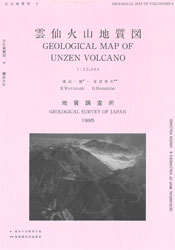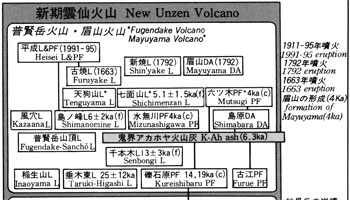Unzen Volcano
Introduction / Geology and petrography of Asama Volcano and environs / Outline of Unzen volcano
Older Unzen volcano / Younger Unzen volcano
Eruptions of 1663-64 and 1792 / Eruptions since 1990
Surveillance and observation of volcanic activities / Concluding remarks
References
![]() PREV
PREV ![]() NEXT
NEXT
Introduction / Geology of Unzen volcano and environs / Outline of Unzen volcano
Introduction
An active volcano, Unzen, situated in western Kyushu, commenced latest eruption in November 1990. The volcano caused much damage in buildings and agriculture in addition to many human casualties by pyroclastic flow in June 1991 and many people are still forced to live in temporary shelters. About 200 years ago in 1792, Mayuyama at the back of City of Shimabara collapsed and from resultant land slide caused in deaths and missing of about 15,000 people, the worst volcanic toll in the history of Japan. Unzen volcano and surrounding areas are well known for beautiful sceneries and many hot springs and are visited by many sight-seers. Agriculture is active taking advantage of warm climate of the area. Unzen volcano has been intimately related to people's life, and prediction of eruption and mitigation of hazard are extremely important.
This volcanic geologic map is prepared to summarize all the available studies, and we wish this is fully utilized for eruption prediction, mitigation of hazard, sight-seeing, and local economic development. Because of the recent activities of the volcano, access was limited, and geology of some areas was based not on the direct field observations but on the interpretation of aerial photographs. References quoted are shown altogether at the end of the text. Some technical terms designated with an asterisk are explained in p. 2.
Geology of Unzen volcano and environs
Basement rocks of the Unzen volcano are Paleogene to middle Pleistocene sedimentary and volcanic rocks. They are exposed in the south of Shimabara Peninsula. Within the geologic map Tonosaka andesite belonging to Minami-Shimabara volcanic rocks is shown in SW corner of the map. It is a part of old volcanic body about 500,000 years before present in age and consists of pyroxene andesite lava.
Outline of Unzen volcano
Unzen volcano is a collective name for a cluster of volcanoes situated in the Shimabara Peninsula with Fugendake in the center occupying an area of 20 km EW by 25 km NS. In the central part of the volcano is Unzen graben with many EW trending faults. The graben is continuing expansion and subsidence.
Unzen volcano consists of two groups; the older ones are dissected volcanoes of Takadake and Kusenbudake and younger ones Fugendake, Mayuyama, Myokendake, and Nodake. The older ones gave K-Ar ages of 500,000 to 100,000 something years before present while the younger ones later than 100,000. It seems that there was a time gap of about 10,000 years between two groups. The total volume of erupted material converted to equivalent lava gives about 44 km3 among which the volume from older group reaches 36 km3 overwhelmingly larger than 8 km3 of younger ones. That is, the framework of Unzen was completed in the older volcano stage. The sequence of younger volcanoes in ascending order is Nodake, Myokendake, Fugendake, and Mayuyama. The ejecta in each volcano are classified into lava, pyroclastic flow deposit, etc. ( ![]() Fig. 1 ).
Fig. 1 ).
Rocks of Unzen volcano : The rocks consist of andesite to dacite and highly viscous. All the rocks contain hornblende as phenocrysts. Rocks are mostly grey- to grayish white-colored characterized by large phenocrysts ( over several mm across ) of plagioclase and hornblende. As rocks from different volcanoes are all similar to each other, identifying the source volcano is not easy with unaided eye. Phenocryst minerals beside hornblende and plagioclase are frequently quartz, biotite, orthopyroxene, clinopyroxene, olivine, and iron minerals. Chemical compositions of rocks are; SiO2 ranging from 57 to 67 %, and richer in K2O and poorer in MgO than average composition of Japanese volcanic rocks. Representative chemical compositions are shown in ![]() Table 1.
Table 1.
![]() PREV
PREV ![]() NEXT
NEXT


